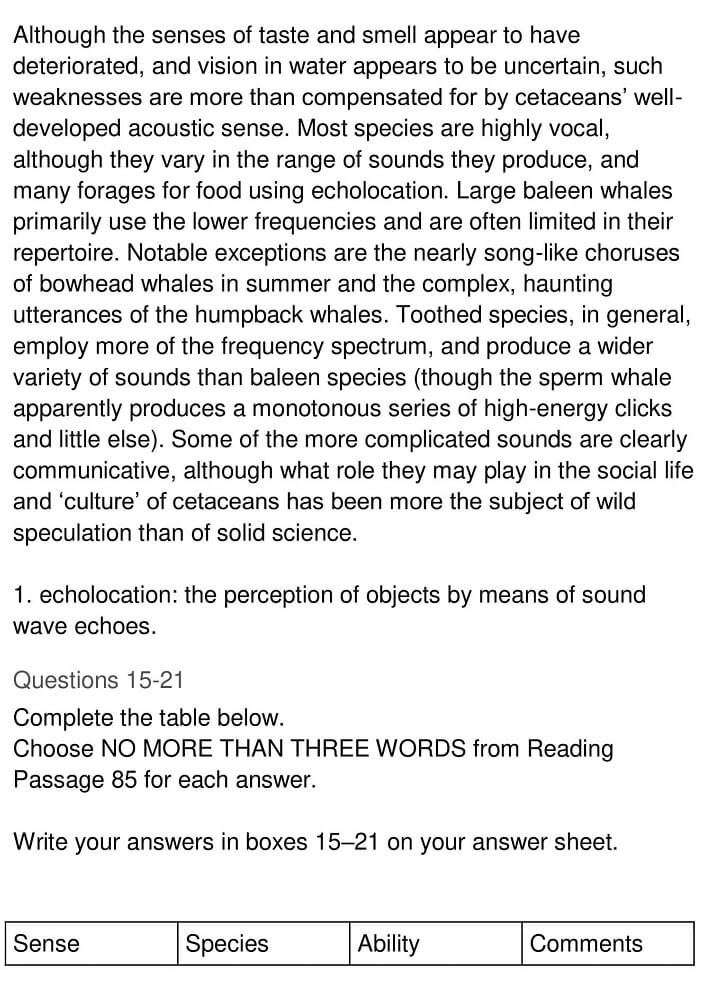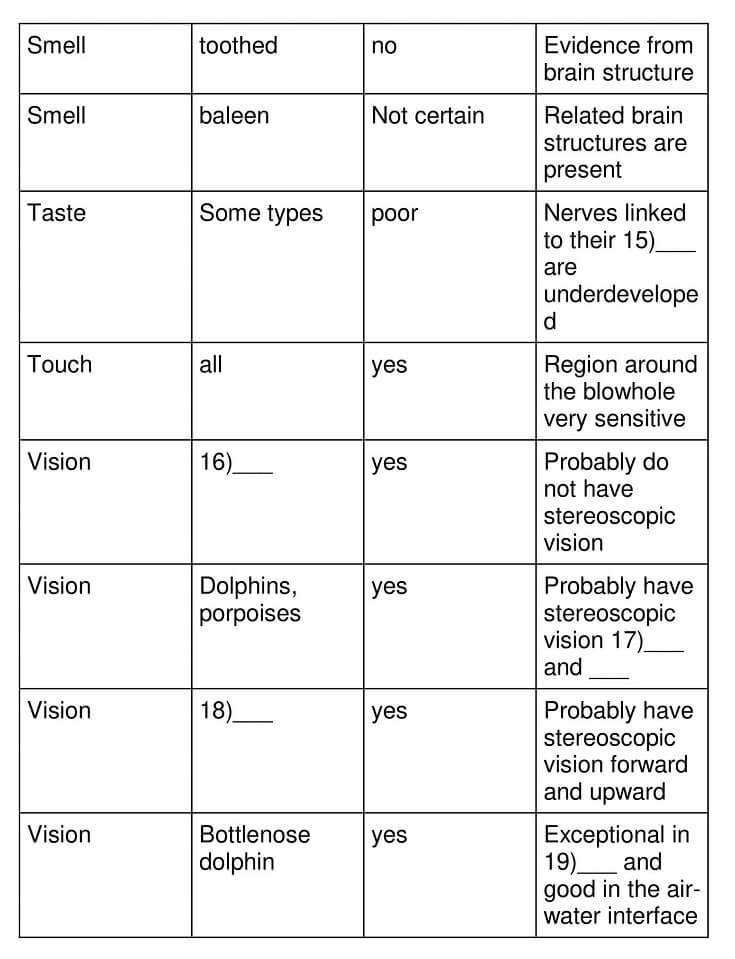What do Whales Feel Reading Answers
5 min read
Updated On
-
Copy link
Table of Contents

Limited-Time Offer : Access a FREE 10-Day IELTS Study Plan!
The Academic passage ‘What do Whales Feel’ is a reading passage that appeared in an IELTS Test.
Since questions get repeated in the IELTS exam, these passages for ideal for practice. If you want more practice, try taking an IELTS reading practice test.
The question types found in this passage are:
Table Completion
A table of information with some gaps will be provided in the table completion question. You are required to fill the gaps with relevant responses from the given reading passage. Focus on the instructions because here, you will be asked to fill the gaps with only a few words. Read them carefully. Some of the options might confuse you, e.g., not more than three words.
Short Answer Questions
In the short answer type of question, you’ll have to take words from the given text to write the short answers. It is important to pay close attention to the instructions that are given in the question because in some instructions there will be a word limit mentioned and you may lose marks if you don’t follow it.
What do Whales Feel






Answers
Unlock All Answers
15 Answer: taste buds
Question Type: Table Completion
Answer location: Paragraph 1, last line
Answer explanation: The last line of paragraph 1 states that at least some cetaceans have ‘taste buds’ and the ‘nerves’ ‘serving’ (linked) ‘these’ (taste buds) have degenerated or are ‘rudimentary’ (underdeveloped). Hence, the answer is ‘Taste buds.’
16 Answer: Baleen whales
Question Type: Table Completion
Answer location: Paragraph 3, last line
Answer explanation: The last line of paragraph 3 mentions that the position of the eyes restricts the field of vision in ‘baleen whales’ in such a way that they probably ‘do not have stereoscopic vision’. Hence, the answer is ‘Baleen whales’.
17 Answer: forward, downward
Question Type: Table Completion
Answer location: Paragraph 4, line 1
Answer explanation: The first line of paragraph 4 observes that the position of the eyes in most ‘dolphins and porpoises’ suggests that they ‘have stereoscopic vision forward and downward’. Hence, the answer is ‘forward, downward’.
18 Answer: freshwater dolphins
Question Type: Table Completion
Answer location: Paragraph 4, line 2
Answer explanation: The second sentence in paragraph 4 points out that the ‘eye position in freshwater dolphins’, which often swim on their side or upside down while feeding, suggests that the ‘vision they have is stereoscopic forward and upward’. Hence, the answer is ‘freshwater dolphins’.
19 Answer: water
Question Type: Table Completion
Answer location: Paragraph 4, line 4
Answer explanation: Paragraph 4 informs that the ‘bottlenose dolphin’ has extremely ‘keen vision in water’. Moreover, judging from the way it watches and tracks airborne flying fish, it can apparently see ‘fairly well through the air–water interface’ as well. Hence, the answer is ‘water’.
20 Answer: lower frequencies
Question Type: Table Completion
Answer location: Paragraph 6, line 3
Answer explanation: Paragraph 6 points out that ‘large baleen whales’ primarily ‘use the lower frequencies’ and are often ‘limited in their repertoire’. Hence, the answer is ‘lower frequencies’.
21 Answer: bowhead, humpback
Question Type: Table Completion
Answer location: Paragraph 6, line 4
Answer explanation: In paragraph 6, the writer notes that most species are highly vocal, but they vary in the range of sounds they produce, and many forages for food using echolocation. Notable exceptions are the nearly ‘song-like choruses’ of ‘bowhead whales’ in summer and the ‘complex, haunting utterances’ of the ‘humpback whales’. Hence, the answer is ‘Bowhead, humpback’.
22 Answer: touch
Question Type: Summary Completion
Answer location: Paragraph 2, line 2
Answer explanation: In paragraph 2, the writer is discussing that the ‘sense of touch’ of the dolphins and whales has sometimes been described as weak, but this view is probably mistaken. The contact may help to maintain order within a group, and ‘stroking or touching’ are ‘part of the courtship ritual’ (mating) in most species. Hence, the answer is ‘touch’.
23 Answer: freshwater dolphin
Question Type: Summary Completion
Answer location: Paragraph 4, line 2
Answer explanation: Paragraph 4 writes about the eye position in ‘freshwater dolphins’, which ‘often swim’ on their side or ‘upside down while feeding’ suggesting that their vision is stereoscopic forward and upward. Hence, the answer is ‘freshwater dolphin’.
24 Answer: airborne flying fish
Question Type: Summary Completion
Answer location: Paragraph 4, line 4
Answer explanation: Paragraph 4 states that the ‘bottlenose dolphin’ has extremely ‘keen vision in water’. Moreover, judging from the way it ‘watches and tracks airborne flying fish’, it can apparently see ‘fairly well through the air–water interface’ as well. Hence, the answer is ‘airborne flying fish’.
25 Answer: clear water
Question Type: Summary Completion
Answer location: Paragraph 5, line 2
Answer explanation: Paragraph 5 points out that ‘vision’ (good visual ability) is obviously ‘more useful’ to species ‘inhabiting’ (living in a specific habitat) ‘clear open waters’ than to those living in turbid rivers and flooded plains. Hence, the answer is ‘clear water’.
26 Answer: acoustic sense
Question Type: Summary Completion
Answer location: Paragraph 6, line 1
Answer explanation: The first sentence of paragraph 6 hints that although the senses of taste and smell appear to have deteriorated, and vision in water appears to be uncertain, such weaknesses are more than compensated for by ‘cetaceans’ ‘well-developed’ (best developed) ‘acoustic sense’. Hence, the answer is ‘acoustic sense’.
Check More IELTS Reading Answers
Also check :
Practice IELTS Reading based on question types

Start Preparing for IELTS: Get Your 10-Day Study Plan Today!
Recent Articles

Nehasri Ravishenbagam

Haniya Yashfeen

Haniya Yashfeen

Haniya Yashfeen




Post your Comments